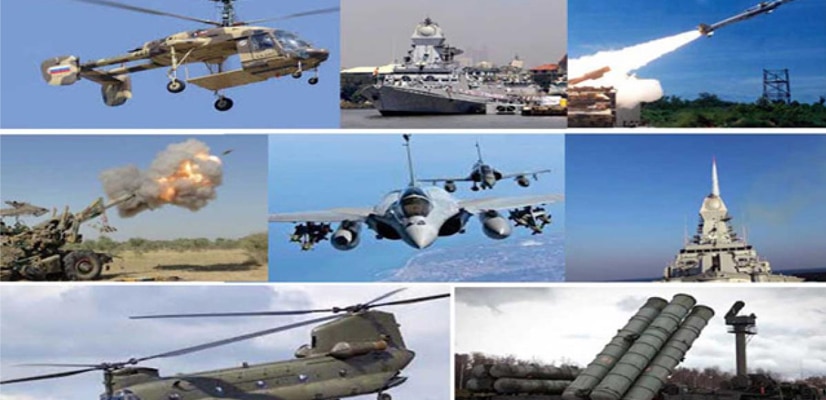The Indian defence sector is important for the economy. The industry can quickly deal with rising matters of national security. In this defence sector, there are 3 branches: the Indian Army, Indian Navy, and Indian Air. Because of this demand for defence equipment and manufacturing in India has been growing due to the issues going in the territorial disputes with Pakistan and China over the ownership of the Northern State of Kashmir and the North Eastern State of Arunachal Pradesh, and other various parts of the country.
Over the last five years, If you look at the history of the Indian defence sector, it has been ranked among the top importers of defence equipment to gain technological advantages over opponent countries such as China and Pakistan. To protect the country with the latest technology through its armed forces and reduce dependency on external defence procurement, the government has taken several initiatives to encourage ‘Make in India’ activities through various changes in policy and planning.
How many sectors are in Indian defence?
India has a domestic defence sector of which 80% is owned by the government. The public sector includes DRDO and its 50 labs,5 defence PSUs, 41 ordnance factories, and 4 defence shipyards. India has a new defence procurement, acquisition and manufacturing policy to decrease imports and magnificent domestic manufacturing.
Defence Companies in India
- Apollo Micro Systems Ltd
- Astra Microwave Products Ltd
- Bharat Dynamics Ltd
- Bharat Electronics Ltd
- Reliance Naval And Engineering Ltd
- Sika Interplant Systems Ltd.
Defence Military Export
According to a document released by Defence Minister Rajnath Singh India exported military hardware and systems worth Rs 35,777 crore in the last seven years, The E-booklet, highlighting the major reforms undertaken by the Ministry of Defence (MoD) in 2020, also mentioned that the defence exports expanded to more than 84 countries.
"The booklet is a reflection of the resolve of the government, under the able leadership of Prime Minister Narendra Modi, to make the defence sector stronger and more efficient," Singh said.
The defence budget of India
The defence budget of India comes in the overall budget of the Union budget of India that is given for the funding of the Indian Armed Forces or you can say Military budget. This budget includes employee salaries and training costs, maintenance of equipment and other facilities, for new or ongoing operations, and development, procurement of new technologies, weapons, equipment, and vehicles.
Expenditures
Share of defence services in the defence budget in 2020-21
- Air Force (23.0%)
- Army (56.0%)
- Navy (15.0%)
- DRDO (6.0%)
- Other (0%)
India's military expenditure and as % of GDP, From 2017- 2022
2017-18
Union Minister for Finance Arun Jaitley allocated ₹359,000 crores of the 2017 Union budget of India for development in the Indian armed forces, marking a rise of around 7% from the previous fiscal year.
2018-19
In the Defence Budget of 2018-19 Finance Minister allocated ₹4,04,365 crore for the Ministry of Defence (MOD). This translates into an expansion of 5.66% over the 2017-18 defence budget.
2019-20
In the year 2019 election year, the NDA government presented an interim budget in place of a regular budget in the interim budget, an allocation amount was ₹4,31,011 crores was made final but on its re-election, the NDA government kept the military budget same and However, the actual expenditure exceeded the approximate amount and the final spending of defence for 2019-20 stood at ₹4,48,820 crores. So there was an expansion of around 10% with respect to the previous budget.
2020-21
On 1 February 2020, the Finance Minister, Nirmala Sitharaman presented the union budget of India in which allocation for defence during the fiscal year 2020-21 stood at ₹4,71,378 crores. This amounted to an expansion of just under 7%.
2021-22
The committee found that the total Defence Budget (including Miscellaneous and Pensions) is Rs 4,78,195.62 crore for the year 2021-22, which is 13.73% of total Central Government Expenditure and 2.15% of GDP for the year 2021-22. Also, the Capital Budget of the Ministry of Defence for 2021-22 is approximately 25.3% of the total capital expenditure of the Central Government Expenditure.
Investments
Foreign Direct Investment (FDI) equity inflow in the defence sector for April 2000 - March 2021 stood at (Rs. 61.52 crore) as per data released by the Department for Promotion of Industry and Internal Trade (DPIIT).
In January 2021, the Institute of Nuclear Medicine and Allied Sciences (INMAS), a Delhi-based DRDO laboratory, presented Rakshita, a bike-based casualty transport emergency vehicle to Central Reserve Police Force (CRPF).
In February 2021, Ministry of Defence (MoD) and Defence Public Sector Undertaking (DPSU) Bharat Electronics Limited (BEL) signed a contract for procurement of Software Defined Radio Tactical (SDR-Tac) worth Rs. 1,000 crore (US$ 137.50 million).
In February 2021, at Aero India 2021 in Bengaluru, Hindustan Aeronautics Limited (HAL) and Mishra Dhatu Nigam Limited (MIDHANI) signed a memorandum of understanding (MoU) for development and production of composite raw materials.
In March 2021, the Defence Ministry signed a Rs. 1,188 crore (US$ 161.2 milion) contract with Bharat Dynamics Ltd. (BDL) and defence public sector enterprise (DPSE) for manufacturing and supplying the French-origin MILAN-2T Anti-Tank Guided Missiles
In March 2021, the Defence Ministry signed a Rs. 1,056 crore (US$ 143.3 million) contract with Mahindra Defence Systems (MDSL) for supply of 1,300 light specialist vehicles to the Indian Army.
In April 2021, Under the Development cum Production Partner (DcPP) programme, Defence Research and Development Organisation (DRDO) allowed private sector firms to develop and produce missile systems, such as vertical launched surface and air missile system programmes, to promote the domestic defence industry.
In April 2021, Defence Research and Development Organisation (DRDO) developed an advanced chaff technology to safeguard the naval ships against a missile attack. Defence Laboratory Jodhpur (DLJ), a DRDO laboratory, has indigenously developed three variants of this critical technology, namely short-range chaff rocket (SRCR), medium-range chaff rocket (MRCR) and long-range chaff rocket (LRCR) that meet Indian Navy’s qualitative requirements. This successful development of advanced chaff technology by DLJ is another step towards ‘Atmanirbhar Bharat’.
In April 2021, Defence Research and Development Organisation (DRDO) Defence Materials and Stores Research lab and Development Establishment (DMSRDE), Kanpur, developed a lightweight bullet proof jacket (BPJ), which weighs 9.0 kilogrammes and meets qualitative requirements of the Indian Army.
In April 2021, Defence Research and Development Organisation (DRDO) developed single crystal blades technology and supplied 60 of these blades to Hindustan Aeronautics Limited (HAL), as part of their indigenous helicopter development programme, for helicopter engine application.
On May 12, 2021, PM CARES Fund approved the procurement of 150,000 units of ‘Oxycare’—SpO2-based oxygen supply system developed by the Defence Research and Development Organisation (DRDO) at a cost of Rs. 322.5 crore (US$ 44.16 million).
On May 17, 2021, the Defence Ministry unveiled the first batch of anti-COVID drug, 2-deoxy-D-glucose (2-DG) developed by the Institute of Nuclear Medicine and Allied Sciences (INMAS), a lab of Defence Research and Development Organisation (DRDO), along with Dr. Reddy’s Laboratories (DRL), Hyderabad.
The government is also inviting foreign players to invest in India and capitalise on the ‘Make in India’ opportunity. In June 2021, Defence Minister, Mr. Rajnath Singh, invited Swedish companies to invest in defence corridors in Uttar Pradesh and Tamil Nadu.
In June 2021, Defence Minister, Mr. Rajnath Singh, approved a proposal for the construction of six submarines at an estimated cost of ~ Rs. 43,000 crore. He also approved proposals regarding capital acquisitions of several equipment for modernisation and operational requirements at an estimated cost of ~ Rs. 6,000 crore . To boost the Indian Government’s ‘self-reliant’ India initiative in June 2021, he also approved the budgetary funds worth Rs.498.8 crore to Innovations for Defence Excellence (iDEX), a Defence Innovation Organisation (DIO) for the next five years.
Future planning
The Indian government is aiming at innovative solutions to empower the country’s defence and security via ‘Innovations for Defence Excellence (iDEX)’, which has offered a platform for start-ups to connect to the defence establishments and develop new technologies, products, weapons in the next five years.
Working through partner incubators, iDEX ‘Innovations for Defence Excellence' has been able to encourage the start-up company to take part in the Defence India Start-up Challenge (DISC) programme.
Rajnath Singh, Defence Minister, Government of India has said the Government is committed to work towards achieving a US$ 26 billion Defence industry by 2025. Addressing the second annual session of Society of Indian Defence Manufacturers here today, he said the Defence sector has been identified as one of the most prominent sectors under Make in India Initiative to realize the US$ 5 Trillion Economy by 2024.




